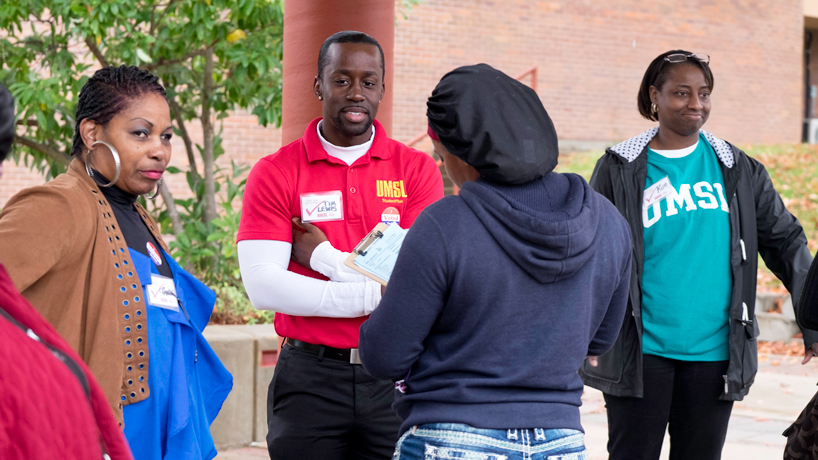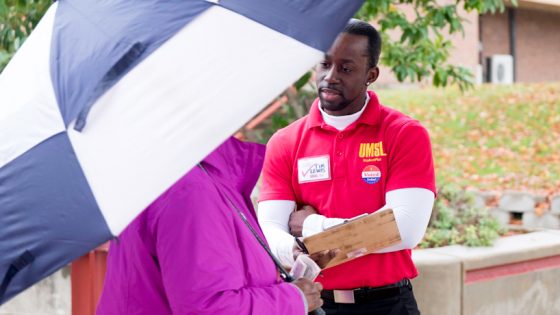
From left, UMSL students Cynthia Davis, Tim Lewis and Kimberly Brown observe voters filling out surveys outside the Dellwood Recreation Center on a rainy Election Day. They were just three of the dozens of political science students participating in an exit-polling project coordinated by Professor David Kimball. (Photos by August Jennewein)
It wound up being a pretty fair trade. The young woman consented to stopping and filling out the short survey after voting early Tuesday afternoon at the Dellwood Recreation Center on West Florissant Road, and Cynthia Davis volunteered to help her elderly mother to the car as a way of offering thanks for her compliance.
While the woman started answering questions on the front and back sides of an 8½ x 11 piece of paper, Davis made sure her mother got settled in the passenger side of the car and stowed her walker across the backseat.
Davis and fellow University of Missouri–St. Louis students Tim Lewis and Kimberly Brown didn’t usually need to go to such admittedly minor lengths to obtain people’s cooperation.
Sure, there were still plenty who refused in the three hours they were on site, beginning just in time for the lunch rush at noon.
“Not right now,” or “It takes too much time” or “I’m in a hurry to get to work,” were among the most common reasons cited, Davis said.
But if anything, she and the other students were surprised at how willing people were to give them a few minutes of their time amid the helter-skelter of Election Day.
“A lot of them responded because we were UMSL students, and they were willing to participate,” Brown said.
Brown, Davis and Lewis were parked about 25 feet from the entrance to the polling place, lucky to have an overhang on a damp and chilly afternoon.
“After lunch, it probably picked up a little,” Lewis said of the participation rate. “I don’t think people were as rushed to get back to work, so those people were more amicable. I guess the last hour that we were at the Dellwood location people were not only just filling out the surveys. They were talking, they were laughing, they were giving their political opinions.”
They weren’t alone. There were UMSL students at polling places throughout St. Louis County at different times of the day. They hit 20 in all and collected more than 400 surveys from voters in a stratified random sample of the county.
It was all part of an exit-polling project led by David Kimball, a professor in UMSL’s Department of Political Science.
He has put other students through a similar exercise during the St. Louis mayoral election in previous years. The results in those instances matched up pretty closely with the overall results of the election.
Kimball developed the project with multiple objectives.

Doctoral student Tim Lewis asks a voter if she will complete an exit-poll survey at the Dellwood Recreation Center. Lewis estimated that he and fellow students had a 50-percent success rate getting voters to participate in the project.
“One is for students to see a little closer up what the election and voting process is like,” he said. “The second is also to get a taste of what political science research is like. Being involved in data collection effort to get some experience seeing what social science research is like to see if they’re interested in doing more of that later in life, either for a thesis or if they’re interested in graduate school or something like that.”
The survey asked respondents how they voted in the three most high-profile races on the fall ballot: President, U.S. Senate and Governor. It also featured basic demographic questions, including age, gender, education level and party affiliation.
Kimball was supervising a separate group of students observing how long voting lines were inside polling places on election day as part of a larger nationwide study, so he added questions about the voting experience – How long were wait times? How helpful were poll workers? – as well. And it asked opinions on local issues such as how people felt about their municipal government or local police department.
Students such as Lewis, a doctoral student in political science currently working on his doctoral dissertation, had an opportunity in the previous month to suggest additional questions based on their research interests.
“I submitted questions on people’s perceptions of racism institutionally,” Lewis said. “I’m trying to contrast whether people are more for particular policies based on whether they feel racism in their particular community versus as a national problem.
“It’s called community context. If you feel racism in your community, the notion is because it’s more of an immediate, in an immediate proximity, you’re more likely to want to support policies like affirmative action compared to if you think it’s an issue nationally but not an issue in your respective community.”
The results of the survey were still being tabulated as of the end of last week, but Kimball expected to be able to discuss them before the start of Thanksgiving break.
The students were already able to value from the experience, whether they were pursuing a future in political science, as Lewis was, or simply using it as an extra credit opportunity in their Introduction to American Politics course, as Davis and Brown, both social work majors, were.
“I’ve been a volunteer poll worker before in 2008 when President Obama was elected,” Brown said. “But it was different being on the outside and seeing the views of the people after they came out.”
Lewis, who also spent two hours during the evening rush hour outside Danforth Elementary on St. Cyr Road in Bellefontaine Neighbors, saw a reaction from voters that he had not expected.
“I anticipated more people filling out the surveys being more opinionated and offering more of their views on political issues,” Lewis said. “I thought this political climate, considering the divisiveness and the contrast between both candidates, that it would have made people more willing to vocalize their political feelings, but I actually got just the opposite. The same people were almost drained, like they were ready for the whole political season to be over with. Like it had deflated them almost.”















